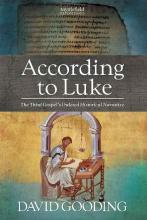
I've said before how valuable I find the writing of David Gooding, particularly on the book of Acts. It turns out his writing on Luke's gospel is just as sharp.
He's just observed that there is a parallel between the widow in Luke 18:1-8 who “cries out” day and night and the blind beggar who “cries out” for mercy (the same Greek verb). He then offers this structure for the section of Luke 17:11-19:28, bounded by journey markers in Luke 17:11 and Luke 19:28 (page 301 of According to Luke)

He's noticing details. Sometimes an author proposes a structure for a biblical book, or a section of one, and it all seems a little far-fetched. Or you're persuaded, but feel you'd never have seen it yourself.
In this case, I find myself looking at this and thinking “of course”. I may not have seen it myself, indeed I hadn't, but he's looking at the text and seeing things that are there rather than reading too much into obscure details.
This kind of structure gets you noticing things. I've read the parable of the pharisee and the tax collector several times. But I've never noticed the links to the Zacchaeus story.
Recent comments